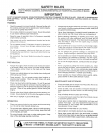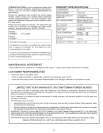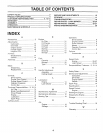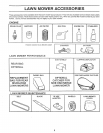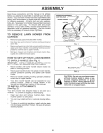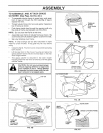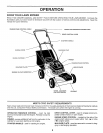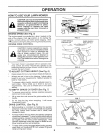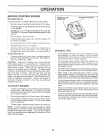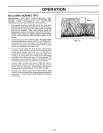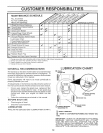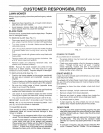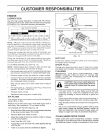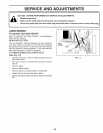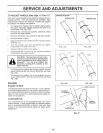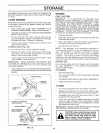
OPERATION
BEFORE STARTING ENGINE
OIL (See Fig. 9)
Your lawn mower is shipped without oil in the engine.
Be sure mower is level and area around oil fill is clean.
Remove engine oil cap w/dipstick and fill to the full line
on the dipstick.
Use 20 ozs. of oil. For type and grade of el! to use, see
"ENGINE" in Customer Responsibilities section of this
manual.
Pour oi! slowly. Do not over fill.
Check oil level before each use. Add oil if needed. Fill
to full line on dipstick.
To read proper level, tighten engine oil cap each time,
Reinstall engine oil cap and tighten.
After the first two (2) hours of mowing, change the oil,
and every 25 hours thereafter. You may need to
change the oil more often under dusty, dirty conditions,
GAS (See Fig. 9}
Fill gasoline tank with fresh, clean, unieaded gasoline.
DO NOT USE PREMIUM GASOLINE. BE CAREFUL
NOT TO OVER FILL TANK.
WARNING: Experience indicates that alcohol blended
fuels (called gasohot or using ethanol or methanol) can
attract moisture which leads to separation and formation of
acids during storage. Acidic gas can damage the fuel
system of an engine while in storage. To avoid engine
problems, the fuel system should be emptied before stor=
age of 30 days or longer. Drain the fuel tank, start the
engine and let it run until fuel lines and carburetor are
empty. Use fresh fue! next season. See Storage Instruc-
tions for additional information. Never use engine or
carburetor cleaner products in fuel tank or permanent
damage may occur.
TO START ENGINE
To start a cold engine, push primer five (5) times before
trying to start. Use a firm push. This step is not usually
necessary when starting an engine which has atready
run for a few minutes.
Move engine speed control lever to fast (,1_) position.
Hold operator presence control bar down to the handle
and pull starter handfe quickly. Do not allow starter
rope to snap back.
To stop engine, retease operator presence control bar.
NOTE: In cooler weather it may be necessary to repeat
priming steps, tn warmer weather over priming may cause
flooding and engine will not start. If you do flood engine,
wait a few minutes before attempting to start and do not
repeat priming steps.
ENGINE OIL CAP
W/DIPSTICK
GASOLINE FILLER CAP
FiG° 9
MOWING TIPS
Undercertain conditions, such as very tatl grass, it may
be necessary to raise the height of cut to reduce
pushing effort and to keep from overloading the engine
and leaving clumps of grass clippings.
o For extremely heavy cutting, reduce the width of cut
and raise the rear of the lawn mower housing one (!)
wheel adjuster setting higher than the front for better
discharge of grass.
For better grass bagging and most cutting conditions,
the engine speed should be set in the fast (-t_) position.
When using a rear discharge lawn mower in moist,
heavy grass, clumps of cut grass may not enter the
grass catcher. Reduce ground speed (pushing speed)
and/or run the !awn mowereverthe area a second time.
If a trail of grass clippings is left on the right side of a rear
discharge lawn mower, mow in a clockwise direction
with a small overlap to collect the clippings on the next
pass.
Keep top of engine around starter clear and dean of
grass clippings and chaff. This will help engine airflow
and extend engine life.
Pores in cloth grass catchers can become filled with dirt
and dust with use and catchers witl collect less grass.
To prevent this, regularly hose catchers off with water
and let dry before using.
10



